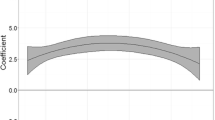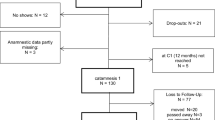Abstract
Rationale
Previous research has shown limited efficacy of nicotine replacement therapy (NRT) among adolescents and generally low compliance rates. As higher compliance rates are associated with improved abstinence rates, the present study examined predictors of NRT compliance.
Objectives
This study aims to test whether different NRT compliance trajectories can be distinguished among adolescents, to test whether these trajectories can be predicted by demographic, smoking-related, and personality factors, and to examine abstinence rates for each trajectory.
Methods
Data were used from a randomized controlled trial that tested the efficacy of nicotine patches versus placebo patches among 265 Dutch adolescents. During NRT treatment, adolescents filled out six online questionnaires in which they reported on the number of days they used the patches. Predictors (i.e., demographic and smoking-related factors and personality characteristics) and end-of-treatment abstinence were also administered through these self-reports. Latent class growth analysis (LCGA) was used to analyze compliance data by classifying individuals into similar growth trajectories.
Results
Three compliance trajectories were found (i.e., “compliers” (n = 89), “moderate decreasers” (n = 41), and “strong decreasers” (n = 127)). The compliers can be characterized by higher levels of conscientiousness and agreeableness and lower levels of extraversion compared with the strong decreasers, and by higher levels of conscientiousness and education compared with the moderate decreasers. Among the compliers, a substantially higher percentage of adolescents achieved abstinence at end-of-treatment (10 %) compared with the moderate decreasers (3 %) and the strong decreasers (6 %).
Conclusions
These findings could be the starting point for person-tailored interventions that aim to enhance NRT compliance rates among adolescents.


Similar content being viewed by others
References
Agrawal A, Lynskey MT (2009) Tobacco and cannabis co-occurrence: does route of administration matter? Drug Alcohol Depend 99:240–247
Alterman AI, Gariti P, Cook TG, Cnaan A (1999) Nicodermal patch adherence and its correlates. Drug Alcohol Depend 53:159–165
Asparouhov T, Muthén B (2012) Auxiliary variables in mixture modeling: a 3-step approach using Mplus. Mplus Webnote 15
Axelsson M, Emilsson M, Brink E, Lundgren J, Torén K, Lotvall J (2009) Personality, adherence, asthma control and health-related quality of life in young adult asthmatics. Respir Med 103:1033–1040
Axelsson M, Brink E, Lundgren J, Lötvall J (2011) The influence of personality traits on reported adherence to medication in individuals with chronic disease: an epidemiological study in West Sweden. PLoS ONE 6:e18241
Axelsson M, Cliffordson C, Lundback B, Lotvall J (2013) The function of medication beliefs as mediators between personality traits and adherence behavior in people with asthma. Patient Prefer Adherence 7:1101–1109
Bagot KS, Heishman SJ, Moolchan ET (2007) Tobacco craving predicts lapse to smoking among adolescent smokers in cessation treatment. Nicotine Tob Res 9:647–652
Bailey SR, Crew EE, Riske EC, Ammerman S, Robinson TN, Killen JD (2012) Efficacy and tolerability of pharmacotherapies to aid smoking cessation in adolescents. Pediatr Drugs 14:91–108
Botello-Harbaum M, Schroeder JR, Collins CC, Moolchan ET (2010) Nicotine replacement therapy use among adolescent smokers seeking cessation treatment. Ethn Dis 20:180–184
Celeux G, Soromenho G (1996) An entropy criterion for assessing the number of clusters in a mixture model. J Classif 13:195–212
Centers for Disease Control and Prevention (2009) High school students who tried to quit smoking cigarettes—United States, 2007. Morb Morb Weekly Report 58:428–431
Cohen NL, Ross EC, Bagby RM, Farvolden P, Kennedy SH (2004) The 5-factor model of personality and anti-depressant medication compliance. Can J Psychiatry 49:106–113
Conrod PJ, Castellanos N, Mackie C (2008) Personality-targeted interventions delay the growth of adolescent drinking and binge drinking. J Child Psychol Psychiatry 49:181–190
Conrod PJ, Castellanos-Ryan N, Strang J (2010) Brief, personality-targeted coping skills interventions and survival as a non-drug user over a 2-year period during adolescence. Arch Gen Psychiatr 67:85–93
DiFranza JR, Rigotti NA, McNeill AD, Ockene JK, Savageau JA, St Cyr D et al (2000) Initial symptoms of nicotine dependence in adolescents. Tob Control 9:313–319
DiFranza JR, Savageau JA, Rigotti NA, Fletcher K, Ockene JK, McNeill AD et al (2002) Development of symptoms of tobacco dependence in youths: 30 month follow up data from the DANDY study. Tob Control 11:228–235
Dolcini MM, Adler NE, Ginsberg D (1996) Factors influencing agreement between self-reports and biological measures of smoking among adolescents. J Res Adolesc 6:515–542
Garber MC, Nau DP, Erickson SR, Aikens JE, Lawrence JB (2004) The concordance of self-report with other measures of mediation adherence. Med Care 42:649–652
Gerris JRM, Houtmans MJM, Kwaaitaal-Roosen EMG, De Schipper JC, Vermulst AA, Janssens JMAM (1998) Parents, adolescents and young adults in Dutch families: a longitudinal study. Nijmegen, the Netherlands: Institute of Family Studies
Gottfredson DC, Wilson DB (2003) Characteristics of effective school-based substance abuse prevention. Prev Sci 4:27–38
Hanson K, Allen S, Jensen S, Hatsukami D (2003) Treatment of adolescent smokers with the nicotine patch. Nicotine Tob Res 5:515–526
Harakeh Z, Scholte RHJ, de Vries H, Engels RCME (2006) Association between personality and adolescent smoking. Addict Behav 31:232–245
Hays JT, Leischow SJ, Lawrence D, Lee TC (2010) Adherence to treatment for tobacco dependence: associations with smoking abstinence and predictors of adherence. Nicotine Tob Res 12:574–581
IBM Corp (2011) IBM SPSS Statistics for Windows, Version 20.0. IBM Corp, Armonk, NY
Jerant A, Chapman B, Duberstein P, Robins J, Franks P (2011) Personality and medication non-adherence among older adults enrolled in a six-year trial. Br J Health Psychol 16:151–169
Johnston LD, O'Malley PM, Bachman JG, Schulenberg JE (2010) Monitoring the future national survey results on drug use, 1975–2009. Volume I: secondary school students. National Institute on Drug Abuse, Bethesda, MD
Killen JD, Fortmann SP, Davis L, Strausberg L, Varady A (1999) Do heavy smokers benefit from higher dose nicotine patch therapy? Exp Clin Psychopharmacol 3:226–233
Killen JD, Robinson TN, Ammerman S, Hayward C, Rogers J, Stone C et al (2004) Randomized clinical trial of the efficacy of bupropion combined with nicotine patch in the treatment of adolescent smokers. J Consult Clin Psychol 72:729–735
Kim Y, Myung SK, Jeon YJ, Lee EH, Park CH, Seo HG, Huh BY (2011) Effectiveness of pharmacologic therapy for smoking cessation in adolescent smokers: meta-analysis of randomized controlled trials. Am J Health Syst Pharm 68:219–226
King PS, Berg CA, Butner J, Drew LM, Foster C, Donaldson D et al (2012) Longitudinal trajectories of metabolic control across adolescence: associations with parental involvement, adolescents’ psychosocial maturity, and health care utilization. J Adolesc Health 50:491–496
Kleinjan M, van den Eijnden RJJM, Engels RCME (2009) Adolescents’ Rationalizations to continue smoking: the role of disengagement beliefs and nicotine dependence in smoking cessation. Addict Behav 34:440–445
Lam TH, Abdullah ASM, Chan SSC, Hedley AJ (2005) Adherence to nicotine replacement therapy versus quitting smoking among Chinese smokers: a preliminary investigation. Psychopharmacol 177:400–408
McCrae RR, John OP (1987) An introduction of the five-factor model and its applications. J Pers 60:175–215
Muthén B, Muthén LK (2000) Integrating person-centered and variable-centered analyses: growth mixture modeling with latent trajectory classes. Alcohol Clin Exp Res 24:882–891
Nylund KL, Asparouhov T, Muthén BO (2007) Deciding on the number of classes in latent class analysis and growth mixture modeling: a Monte Carlo simulation study. Struct Equ Model 14:535–569
O’Loughlin J, DiFranza J, Tyndale RF, Meshefedjian G, McMillan-Davey E, Clarke PBS et al (2003) Nicotine-dependence symptoms are associated with smoking frequency in adolescents. Am J Prev Med 25:219–225
Okuyemi KS, Zheng H, Guo H, Ahluwalia JS (2010) Predictors of adherence to nicotine gum and counseling among African–American light smokers. J Gen Intern Med 25:969–976
O'Leary-Barret M, Mackie CJ, Castellanos-Ryan N, Al-Khudhairy N, Conrod PJ (2010) Personality-targeted interventions delay uptake of drinking and decrease risk of alcohol-related problems when delivered by teachers. J Am Acad Child Adolesc Psychiatry 49:954–963
Olino TM, Klein DN, Lewinsohn PM, Rohde P, Seeley JR (2010) Latent trajectory classes of depressive and anxiety disorders from adolescence to adulthood: descriptions of classes and associations with risk factors. Compr Psychiatry 51:224–235
Otten R, Engels RCME, van den Eijnden RJJM (2008) Smoking behavior in asthmatic and non-asthmatic adolescents: the role of smoking models and personality. Subst Use Misuse 43:341–360
Patrick DL, Cheadle A, Thompson DC, Diehr P, Koepsell T, Kinne S (1994) The validity of self-reported smoking: a review and meta-analysis. Am J Public Health 84:1086–1093
Raynor DA (2004) Adherence to pharmacological smoking cessation treatment among weight-concerned women. PhD dissertation, University of Pittsburgh
Schafer JL (1999) Multiple imputation: a primer. Stat Methods Med Res 8:3–15
Scherphof CS, van den Eijnden RJJM, Engels RCME, Vollebergh WAM (2014) Short-term efficacy of nicotine replacement therapy for smoking cessation in adolescents: a randomized controlled trial. J Subst Abuse Treat 46:120–127
St Pourcain B, Mandy WP, Heron J, Golding J, Smith GD, Skuse DH (2011) Links between co-occurring social-communication and hyperactive-inattentive trait trajectories. J Am Acad Child Adolesc Psychiatry 50:892–902
Stapleton JA, Russell MA, Feyerabend C, Wiseman SM, Gustavsson G, Sawe U, Wiseman D (1995) Dose effects and predictors of outcome in randomized trial of transdermal nicotine patches in general practice. Addiction 90:31–42
Stead LF, Perera R, Bullen C, Mant D, Lancaster T (2008) Nicotine replacement therapy for smoking cessation. Cochrane Database Syst Rev Issue 1. Art. No.: CD000146
STIVORO (2012) Roken, de harde feiten: jeugd 2012 [Smoking, the harsh facts: youth 2013]. STIVORO-voor een rookvrije toekomst, The Hague
Thompson K, Kulkarni J, Sergejew AA (2000) Reliability and validity of a new Medication Adherence Rating Scale (MARS) for the psychoses. Schizophr Res 42:241–247
Van Zundert RMP, Boogerd EA, Vermulst AA, Engels RCME (2009) Nicotine withdrawal symptoms following a quit attempt: an ecological momentary assessment study among adolescents. Nicotine Tob Res 11:722–729
Verdurmen J, Monshouwer K, van Dorsselaar S, Lokman S, Vermeulen-Smit E, Vollebergh W (2012) Jeugd en riskant gedrag 2011. Kerngegevens uit het peilstationsonderzoek scholieren. Trimbos-Instituut, Utrecht
Vermulst AA, Gerris JRM (2005) Quick Big Five Persoonlijkheidsvragenlijst. Handleiding [Quick Big Five Personality Questionnaire. Manual]. LDC, Leeuwarden
Zugelj U, Zupancic M, Komidar L, Kenda R, Varda NM, Gregoric A (2010) Self-reported adherence behavior in adolescent hypertensive patients: the role of illness representations and personality. J Pediatr Psychol 35:1049–1060
Conflict of interest
No conflicts of interest were reported by the authors of this paper.
Funding
This study is funded by the Netherlands Organization for Health Research and Development (ZonMw).
Author information
Authors and Affiliations
Corresponding author
Rights and permissions
About this article
Cite this article
Scherphof, C.S., van den Eijnden, R.J.J.M., Lugtig, P. et al. Adolescents’ use of nicotine replacement therapy for smoking cessation: predictors of compliance trajectories. Psychopharmacology 231, 1743–1752 (2014). https://doi.org/10.1007/s00213-014-3511-8
Received:
Accepted:
Published:
Issue Date:
DOI: https://doi.org/10.1007/s00213-014-3511-8




